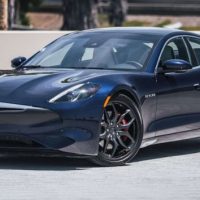
 Karma Automotive(NEW YORK) — Detroit may be the nation’s hub of car manufacturing and engineering, but 3,000 miles away in Southern California, a boutique automaker is looking to reclaim a place at the table.
Karma Automotive(NEW YORK) — Detroit may be the nation’s hub of car manufacturing and engineering, but 3,000 miles away in Southern California, a boutique automaker is looking to reclaim a place at the table.
It’s not trying to be the next General Motors, Ford or even Tesla. But Karma Automotive is hoping for a comeback that will jolt the industry nonetheless — tying its fate to a fleet of new electrified vehicles, including a lithe 535 horsepower plug-in hybrid sedan.
In 2014, Karma Automotive emerged from the remnants of Fisker Automotive, the eco-minded manufacturer of plug-in hybrid sports cars founded by veteran auto designer Henrik Fisker that experienced a meteoric rise and precipitous fall. Fisker was at the forefront of the electric revolution in 2007, years before mainstream automakers, with the exception of Toyota, took hybrids and pure electric vehicles seriously.
When Fisker unveiled the Fisker Karma concept in 2008, the world took notice. Celebrities lined up to get one. It was instantly declared one of the most beautiful cars — ever. Even the Department of Energy jumped on the bandwagon, loaning the company $529 million. Fisker Karma would become the new symbol of the U.S. automotive industry, a perfect example of the Obama administration’s efforts to boost fuel efficiency across the U.S. auto industry.
Then the dream suddenly imploded. Henrik Fisker walked away from the business. The company declared bankruptcy. Wanxiang, a privately-owned Chinese auto parts company, later swooped in and purchased the remaining assets at a fire-sale price of $149 million.
Fast forward five years. The company, still based in Irvine, California, now goes by Karma Automotive. This spring, it introduced the 2020 Revero GT, a sinuous plug-in hybrid sedan and a much improved version of its first Revero vehicle, dubbed 1.0 internally, in 2017. At the Shanghai auto show in April, two more Karmas were shown off: the SC1 Vision concept electric vehicle and a GT concept designed in partnership with Pininfarina, the legendary Italian design and engineering house.
This appears to be only the beginning for the burgeoning automaker. The GT will make its North American debut at Monterey Car Week in California starting Aug. 15.
“We come from Fisker but we are not Fisker anymore,” Dr. Lance Zhou, Karma Automotive’s CEO, told ABC News in a recent interview at the company’s headquarters. “We can utilize history to move our company forward.”
Every Karma vehicle will be produced at the company’s Innovation and Customization Center (KICC), a $100 million facility in Moreno Valley, California. Thirty percent of Karma’s future inventory will be range extenders (plug-in hybrids) versus 70 percent of pure electric vehicles. In addition to the Revero GT and two concepts, an SUV, convertible and compact SUV are in the works.
“We will have everything – no company can survive on one car,” Zhou said.
Expansion plans are moving rapidly: the company expects to launch in 19 countries by next year and build out its limited dealer network. The company has also been actively hiring, staffing up for the coming push both across North America and in Europe. A public offering may happen as soon as 2021.
Karma’s comeback hinges on the success of the Revero GT, which officially enters production in September with customer deliveries beginning in the fourth quarter. The goal is to sell 500 in the first year and the company has already received “hundreds” of deposits from interested buyers, according to Zhou, including some customers in China. How the public responds to the Revero GT will be turning a point for Karma, especially since 75% of the vehicle was completely overhauled from the 2017 version.
“The Revero 2.0 is all new and on my watch,” Bob Kruse, Karma’s chief technology officer, told ABC News before a test drive of the prototype. “We have retuned the suspension, improving the ride and handling at the same time.”
Kruse, an industry veteran who led GM’s strategy behind the Chevrolet Volt, joined Karma in 2017. He didn’t like what he saw on the 2017 Revero — “that car was built with a lot of parts we got out of the Fisker bankruptcy” — so he set out on engineering a better version. The 2020 Revero is 357 pounds lighter, quicker and more responsive. Kruse replaced the old GM engine, which he said “sounded a bit like a tractor,” with a new, more efficient BMW 1.5L turbo three-cylinder engine that was recalibrated and enhanced with Karma’s in-house technology.
“We added some tech to the exhaust system, changed the pedal map,” he noted. “The throttle is more aggressive and in sport mode you get more performance and a very robust sounding exhaust note.”
His team was also able to upgrade the lithium ion battery power from 20 to 28 kilowatt hours, boost the range in “stealth,” or electric mode, from 50 miles up to 80 (total range extends to 360 miles when the generator kicks in and the car is fully charged) and shave nearly a full second off the 0-60 mph time of 4.5 seconds.
The Revero GT also produces 536 horsepower and 550 lb.-ft of torque.
“We have an on-board generator that can make electricity to supplement the battery,” Kruse noted. “All of our torque and propulsion comes electrically. Once you drive an electric vehicle and get used to that instant torque, it’s very addicting. When you step on the accelerator your head will snap and your face will smile.”
The battery and motors were not the only changes; the Revero’s interior got an entire makeover, including the headliner, infotainment console, seats and steering wheel. The latest safety technologies were added and Kruse and his team developed a proprietary sound system that Kruse said trounces the competition.
Customers who decide to shell out $135,000 on the Revero GT will likely be impressed with the finished product. Everything about the new vehicle is better: the controls, comfort, styling, driving performance and electric range.
“The Revero failed to take off in 2017 but the Moreno Valley plant was also brand new with an untested workforce, limiting their ability to crank out cars,” according to Ed Kim, a longtime automotive industry expert and vice president of industry analysis at AutoPacific. “The Revero 1.0 was pretty much an exact carbon copy of the Fisker Karma and launched with uninspiring performance and range that was acceptable in 2011 when the original Fisker version launched, but not in 2017.”
“The new Revero GT appears to fix the first version’s performance and range,” Kim added.
Sunil Pandya, a physician and health tech entrepreneur in Florida, bought a Fisker Karma in 2012 after falling in love with it.
“I loved the name, it was amazing to look at and at the time had cutting-edge technology,” he told ABC News by phone. “I put 20,000 miles on it but there were engine issues, fit and finish problems. It was beautiful but a gamble.”
The vehicle’s constant problems, however, forced him to park it in the garage.
“It was a paperweight,” Pandya said.
His poor experience did not deter him from owning the Revero that emerged post-bankruptcy — he’s on his second vehicle and will be one of the first customers to have the Revero GT later this year. A self-described car addict, Pandya said his 23 other cars — including McLarens, Lamborghinis and Teslas — are not as special as his Revero.
“I feel more exclusive with the Karma,” he said. “It’s a hybrid exotic that looks sexy and is an eye catcher.”
For Andreas Thurner, a former Rolls-Royce designer and Karma’s vice president of global design, the company presented an opportunity for him to “be small” again. He convinced others to follow his lead and join the startup.
“They all left good, secure jobs from established OEMs [original equipment manufacturer] because they all wanted something new,” he told ABC News. “You have to take the risk sometimes.”
He said the Karma name “gives us some recognition as opposed to zero” but acknowledged the company has to work with “world class people” to compete in the cutthroat luxury space.
“We are in a transition phase,” he said. “We have to inspire people. Karma is very design focused. We build show cars for the street. It’s a huge opportunity to be at Karma.”
Zhou and other executives eagerly tout the company’s Southern California roots at every opportunity. Car colors are influenced by the state (Borrego Black, Pacifico Grey, Balboa Blue, Napa Red) and the wood in the Revero GT cabin comes from felled trees in King Gillette Ranch national park. Customers who choose the wood option will receive a personal certification authenticating the material’s Californian birthplace.
“We 100% believe in California,” Zhou noted. “People here will resonate with the car.”
Jeff Schuster, president of global vehicle forecasting at LMC Automotive, said some Americans may be leery of buying a car from a Chinese automaker.
“On top of the naming issue, being a Chinese company in the current political environment adds another layer of risk for generating sales,” he told ABC News. “They clearly are trying to overcome the Chinese ownership reality by boasting about being a California-based company.”
Zhou disputed that Wanxiang has any involvement in Karma’s business.
“We’re an American company,” he asserted. “There is no Chinese government influence.”
Karma may be forever linked to Henrik Fisker but Kim said there are “absolutely” second chances in the automotive industry.
“Fisker’s bankruptcy didn’t involve product issues that crippled other brands that stumbled in spectacular public fashion,” he said. “Hyundai launched strong when it debuted for the 1986 model year, but poor quality and reliability sent sales tumbling quickly and it was decades until Hyundai was re-established as a builder of excellent vehicles. Audi faltered in the 1980s with a 60 Minutes report on unintended acceleration, and it similarly took well over a decade for the brand to recover because the issue was related to safety.”
Thurner said Karma has its sights set on one goal: to produce the best and most beautiful cars on the market.
“The new Revero is a huge departure from where we came from,” he said. “We’re not backwards-looking. We’re not nostalgic. It’s a fantastic starting point but let’s look into the future.”
Copyright © 2019, ABC Radio. All rights reserved.















